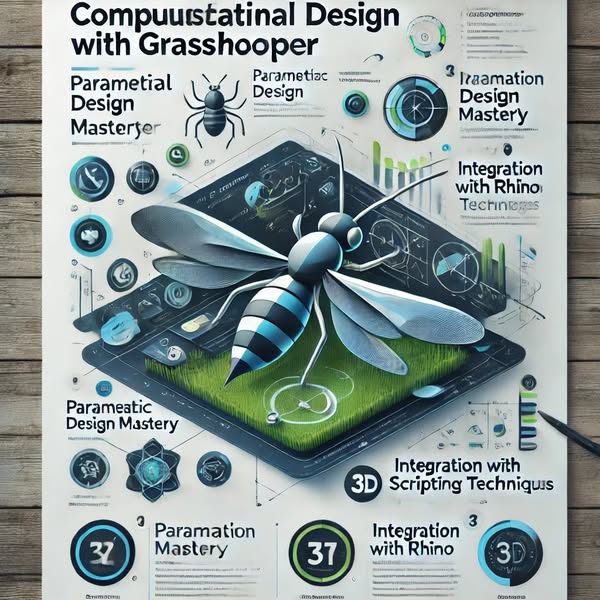
About Course
🧠 Computational Design with Grasshopper for Architects
Course Code: 3011-ARC
Title: Parametric and Environmental Design using Grasshopper and Rhino
📘 Introduction & Description
This course introduces architects and designers to computational design using Grasshopper for Rhino. It bridges the gap between design and programming, empowering participants to generate and analyze complex architectural forms through visual scripting. Participants will gain hands-on experience in parametric modeling, optimization, and connecting design with environmental and structural simulations.
🎯 Objectives
- Understand the fundamentals of computational and parametric design.
- Create intelligent architectural forms using visual programming.
- Integrate environmental and structural analysis into the design process.
- Apply data-driven design thinking to real-world architectural challenges.
👥 Target Audience
- Architecture professionals and students.
- Interior and urban designers interested in parametric methods.
- Civil engineers and designers exploring environmental & structural optimization.
- Enthusiasts of digital architecture and generative design.
📅 Time Frame
- Duration: 5 Weeks
- Total Hours: 15 hours
- Format: Weekly 3-hour sessions (theory + practical)
🧩 Detailed Course Outline
|
Week |
Topic |
Description |
|
Week 1 |
🌐 Introduction to Rhino & Grasshopper |
Understanding UI, data structures, and geometry basics |
|
Week 2 |
🔁 Visual Scripting Logic |
Inputs, operations, components, lists, and trees |
|
Week 3 |
🧮 Mathematical Modeling & Parametrics |
Functions, attractors, and geometric control through equations |
|
Week 4 |
🌱 Environmental & Structural Analysis Integration |
Linking with tools like Ladybug/Honeybee, Karamba, and using external data |
|
Week 5 |
🏗️ Capstone Project |
Design, simulate, and present a responsive architectural model with performance analysis |
📦 What You Will Learn
- How to use Grasshopper with Rhino for parametric modeling.
- Creating adaptive and data-driven forms using mathematical functions.
- Running performance-based simulations (e.g., sunlight, wind, structure).
- Exporting data and designs for further architectural development.
📁 Materials Included
- Digital handouts and slides
- Sample Grasshopper scripts
- Rhino & Grasshopper models
- Plugin guides: Ladybug, Karamba, Galapagos
🧑🏫 Instruction Format
- Instructor-led live sessions
- Hands-on practical labs
- Weekly exercises and mini challenges
- Final presentation and feedback session
📅 Detailed Course Outline
Week 1: Introduction to Rhino & Grasshopper
- Overview of computational design and parametric thinking
- Navigating the Rhino 3D interface
- Introduction to Grasshopper: UI, canvas, and basic components
- Understanding data types: numbers, points, vectors, curves
- Creating simple parametric forms (walls, towers, panels)
Week 2: Visual Scripting Logic & Data Structures
- Working with lists, data trees, and hierarchy in Grasshopper
- Introduction to logical operators and conditional workflows
- Organizing and managing complex definitions
- Practical exercises on repetition, patterns, and modularity
- Creating re-usable design systems
Week 3: Mathematical Modeling & Form Generation
- Using mathematical expressions to control geometry
- Attractors and field-based design (gravity, magnetism, etc.)
- Implementing adaptive skins, dynamic façades, and towers
- Graph mappers and remapping values
- Real-world architectural applications
Week 4: Environmental and Structural Integration
- Using plugins:
- 🌞 Ladybug/Honeybee for solar, daylight, energy simulations
- 🧱 Karamba for structural stress and deformation analysis
- Connecting parameters with real-world performance data
- Data visualization: graphs, charts, colored meshes
- Optimizing form based on analysis results
Week 5: Final Project & Presentation
- Design and implement a parametric architectural model
- Apply environmental and/or structural analysis
- Document process: sketches, diagrams, scripts
- Present a final video or board showing design logic and performance
- Group review and instructor feedback
✅ Learning Outcomes (What You Will Learn)
By the end of this course, you will be able to:
- 🧠 Think parametrically: Understand how to generate flexible and adaptive architectural forms using data and logic
- 🧰 Use Grasshopper confidently to create and manipulate geometry
- 🧮 Apply mathematical and algorithmic control to design
- 🌞 Integrate environmental analysis tools to evaluate and optimize designs
- 🏗️ Connect with structural analysis tools like Karamba
- 🛠️ Build real-time responsive models that adapt to context and constraints
- 📈 Visualize data and performance metrics in your models
- 🎓 Present a fully parametric and analyzed architectural project
Course Content
🧠 Computational Design with Grasshopper for Architects
Student Ratings & Reviews



